Prowess is relatively young mechanic in Magic. It premiered in Khans of Tarkir, back in September of 2014. Since then, cards like [casthaven]Monastery Swiftspear[/casthaven], [casthaven]Abbot of Keral Keep[/casthaven], and [casthaven]Monastery Swiftspear[/casthaven] have made waves in all Constructed formats. Burn is a completely different animal with a new one drop, and Vintage dramatically shifted to accommodate sudden surprise armies of Mox-loving monks.
Now that Prowess has had time to mature, we’ve had a chance to see just how good it is. Few cards communicate its progression better than [casthaven]Spellweaver Eternal[/casthaven], the aggressive blue beater murdering people and getting blanked in Hour of Devastation Limited.
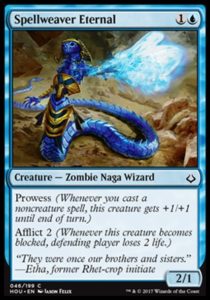 Prowess’ Value
Prowess’ Value
[casthaven]Spellweaver Eternal[/casthaven] is a straightforward card. It has two keywords—Prowess and Afflict 2. It’s a 2/1 for 2 in a format and color which rewards tempo aggro. It’s a a strict upgrade to Oath of the Gatewatch’s [casthaven]Umara Entagler[/casthaven], having a second ability, a more relevant creature type (blue zombies have more support in Amonkhet than blue allies did in Battle for Zendikar), and the benefit of being in a format friendlier to 2/1s for two.
[casthaven]Spellweaver Eternal[/casthaven] makes me wonder just what Prowess is worth. After all, a 2/1 for two is below the curve at common, but not by that much (particularly for blue, which doesn’t get [casthaven]Grizzly Bears[/casthaven] at common). So, how much mana does having Prowess add to a creature (or alternatively, how much power does a creature need to lose in order to get Prowess)? There’s no hard and fast rule as to how much mana keyword abilities add to a card’s cost, but we can draw some conclusions from past evidence.
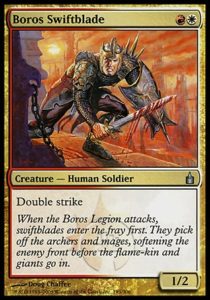
Double Strike tends to add ~1.5 mana; [casthaven]Fencing Ace[/casthaven] is a 1/1, which lacking abilities is worth zero mana ([casthaven]Memnite[/casthaven] is a perfect example, but any Limited player worth their salt knows that a 1/1 isn’t worth one mana). Add in Double Strike and it costs two mana. [casthaven]Iroas`s Champion[/casthaven] is a 2/2, which without abilities is worth a little less than two mana; add in a second color and a third mana and you’re about square.
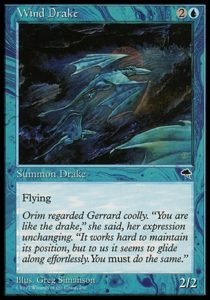
Flying tends to add ~1 mana. [casthaven]Wind Drake[/casthaven] is a 2/2, which is worth a little less than two mana (but is a bit more expensive in blue because blue doesn’t get common [casthaven]Grizzly Bears[/casthaven]). Add in flying (which blue gets a slight discount on, since blue is one of the two colors primary at flying) and it costs three mana. [casthaven]Welkin Tern[/casthaven] is a 2/1 for two, which is worth about 1.5 mana (they tend to cost 2 and have a slight upgrade). Give it flying (which pushes it over 2 mana) and a downgrade and you’ve got a solid two drop.
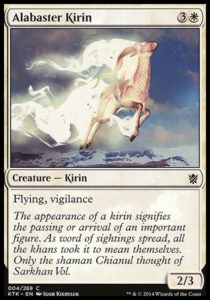
Vigilance tends to add ~0.5 mana. [casthaven]Herald of Dromoka[/casthaven] and [casthaven]Sentinel Sliver[/casthaven] are 2/2s for two, which is worth about 1.5 mana. Give them Vigilance and you still have room to add another ability on top of it for two mana. [casthaven]Misthoof Kirin[/casthaven] is a 2/1 flying for three with Megamorph. It’d almost certainly cost three without Vigilance, so it’s able to have that ability basically for free. [casthaven]Tajuru Pathwarden[/casthaven] is a 5/4 trample, which at common is going to cost you five mana. Once again, by virtue of costing less than a full mana, Vigilance is a freebie for a creature not already stretching the bounds of its mana cost.
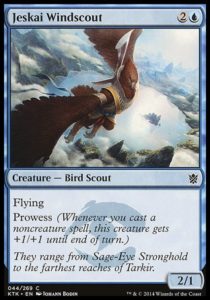
The Cost of Prowess
At common, Prowess tends to be on creatures with moderate to decent bodies. There’s the now-classic 1/3 Prowess for two mana ([casthaven]Jeskai Student[/casthaven], [casthaven]Sanguinary Mage[/casthaven], and mostly recently [casthaven]Nimble-Blade Khenra[/casthaven]), where a subpar 1/3 body gets a minor upgrade from having prowess. We’ve seen 2/1 flyings for three in [casthaven]Jeskai Windscout[/casthaven] and [casthaven]Niblis of Dusk[/casthaven], which tended to be a little worse than [casthaven]Wind Drake[/casthaven] (both had coexisted with 1/1 flying spirit tokens and commonly played one-damage removal spells). For all these creatures, prowess was substantially worse than an extra point of power, and arguably weaker than an extra point of toughness.
To make a (potentially bold) claim, only one common creature has ever substantially benefited from having Prowess: [casthaven]Ingenious Skaab[/casthaven]. It gave [casthaven]Watercourser[/casthaven] (already a solid common and worth three mana) a free ability that synergizes well with its ability. Every other creature with prowess has suffered from either being overcosted, lacking a point of power/toughness relative to what it would normally have at that mana cost, and the awkwardness of Prowess.
To make a second (and bolder) claim, Prowess is exciting but weaker than it looks. Sure, it gives extra value to your noncreature spells as pump effects, but making it work is a serious hoop to jump through, particularly in Limited. You must:
- Spend a card to trigger Prowess
- Have an instant if you want it to function as a combat trick
- Have a sufficient density of noncreature spells in order to utilize and/or threaten Prowess
- Hold your noncreature spells until they are most effective, potentially contorting your curve and play
- Have an opportunity for the buff to matter (either by winning in combat, trading up, or pulling ahead in a race)
In Constructed, these hoops are easier to jump through. [casthaven]Monastery Swiftspear[/casthaven] is in Burn, a deck with an enormous amount of noncreature spells and which wants ways to force through damage. [casthaven]Monastery Mentor[/casthaven] is in a format full of cantrips and mana sources that trigger prowess. [casthaven]Abbot of Keral Keep[/casthaven] is plenty good enough without Prowess, and [casthaven]Seeker of the Way[/casthaven] has super prowess which has a dramatic effect if only triggered once.
So, what does Prowess cost? I think a fraction of a mana, certainly less than an ability like Vigilance. Vigilance functions all the time without requiring any extra work, whereas Prowess requires external support to do anything at all, and has all the restrictions previously mentioned. Prowess is inconsistent, and while it can be explosive, it often does nothing at all.
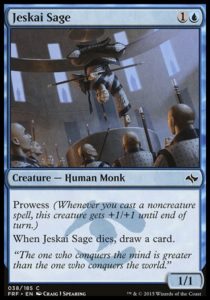
A Prowessing Future
It’s great that Prowess is an inexpensive ability. Something like Double Strike, which is very powerful and scales dramatically with creature size, can’t be thrown around willy-nilly, only appearing on a small number of cards. However, a weaker ability like Prowess can be tacked onto creatures to make them just a little more powerful at no additional cost. We’ve already seen this with cards like [casthaven]Ingenious Skaab[/casthaven], [casthaven]Spellweaver Eternal[/casthaven], and [casthaven]Ringwarden Owl[/casthaven].
Going forward, I expect to see a whole lot more Prowess. It’s an easy to develop ability, as it relies on the power level, cost, and speed of supporting noncreature spells. It creates great opportunities for bluffing and feeling smart. It’s capable of generating absolute blowouts, but more often, it won’t, or will only threaten said blowouts. It has a lot of opportunities for synergy, from [casthaven]Ingenious Skaab[/casthaven], to [casthaven]Spellweaver Eternal[/casthaven], to [casthaven]Sage-Eye Avengers[/casthaven]. I further expect that we will see creatures that are already high-pick commons gaining prowess without increasing their cost.
Prowess is especially useful for developing UR archetypes for Limited. Of the five colors, blue and red have the fewest creatures. Because creatures are the most important cards in Limited, that means UR is an inherently weak archetype. Blue and red have many spells, but you can only fit so many into a Limited deck without going too low in your creature count. Prowess helps add some heft to the creatures UR does have, making those creatures more efficient and therefore ten or twelve creatures can potentially fill the role of the fifteen or more creatures that most Limited decks need.
I look forward to the day when a prowess creature is printed and I underestimate its prowess. Until then, and as always, thanks for reading.
—Zachary Barash
Zachary Barash is a New York City-based game designer. He works for Kingdom Death: Monster, has an MFA in Game Design from NYU, and does freelance game design.
His favorite card of the month is [casthaven]Unconventional Tactics[/casthaven]. It’s rare to see humor like this in a card not featuring goblins, but it manages to succeed on several levels. [casthaven]Unconventional Tactics[/casthaven] manages to tell a silly, dark, and sad tale of mindless zombies who really want to serve jumping off a ramp. It’s a light, subtle, and poignant moment amid the dark background of Hour of Devastation. On the design side, it manages to revamp [casthaven]Angelic Blessing[/casthaven]—by giving it a tiny tribal theme, it suddenly becomes a weird card advantage/aggro engine. And it does all of that without you even needing to notice.

